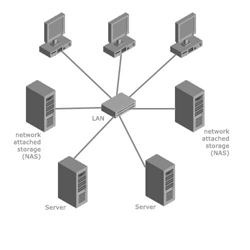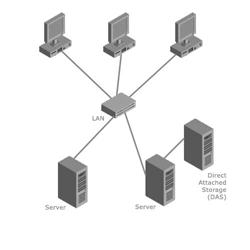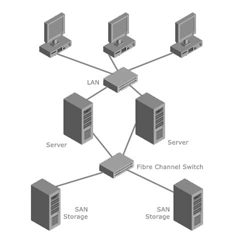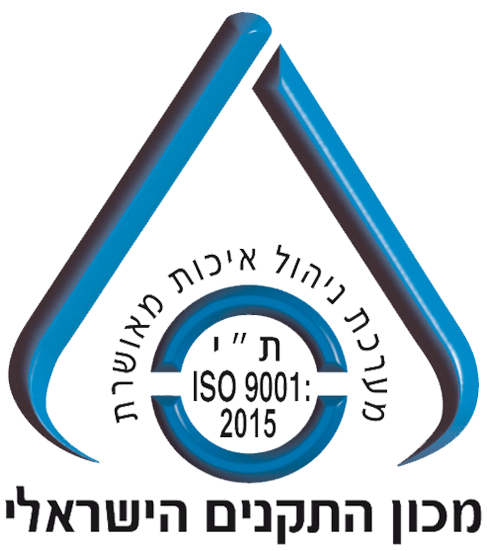Network Attached Storage (NAS)
Network Attached Storage Servers are the easiest and most cost effective way of adding Storage to your network.
One approach to scaling storage without having to scale servers at the same time is the use of NAS - Network Attached Storage - which connects directly to an IP LAN and is available to all servers - receiving, storing and returning data as files from a mix of different operating system types.
NAS is a storage appliance that stores and manages data access and retrieval on behalf of a number of IP attached Servers and Users. One of the biggest advantages of a NAS system is that it is can be attached anywhere to the network with the minimum disruption and impact on operational procedures. NAS can offer a quick and easy point solution to IT centre data storage challenges.
If you're need to increase the available Storage on your network without the cost implications of deploying a traditional File Server, we offer a range of NAS products that can be attached quickly and directly to your Ethernet Network to provide significant additional Disk Capacity at a very competitive price point.

Direct Attached Storage (DAS)
Direct Attached Storage is the data storage connection system which most people are familiar with.
Typically DAS is a disk drive or disk subsystem which is either in the same enclosure as the server or attached by a short heavy cable.
Direct Attached Storage (DAS) is normally connected to the server which ‘owns’ it, by a SCSI bus. There have been many technologies used to actually connect the disk to the computer: the most common are SCSI, IDE/ATA Fibre Channel and SATA.
This is typically a JBOD (Just a Bunch of Disks) configuration. Managing how the data on the disk drives is organised is under control of the server. Increasing the available storage space can mean either adding a server with its own storage to a network or bringing down a server and reconfiguring the disk system.

Fibre Channel Storage Area Network (SAN)
A SAN (Storage Area Network) is an architecture designed to meet the requirement of networking data storage behind the server.
The SNIA (Storage Network Industry Association) definition of a SAN is: ‘A network whose primary purpose is the transfer of data between computer systems and storage elements and among storage elements. (Abbreviated SAN). A SAN consists of a communication infrastructure, which provides physical connections, and a management layer, which organises the connections, storage elements, and computer systems so that data transfer is secure and robust.’
The definition does not specifically identify the term SAN with Fibre Channel technology. When the term SAN is used in connection with Fibre Channel technology, use of a qualified phrase such as "Fibre Channel SAN" is encouraged.
According to this definition an Ethernet-based network whose primary purpose is to provide access to storage elements would also be considered a SAN - an IP SAN. Fibre Channel has become the ‘infrastructure of choice’ for SANs through its ability to deliver large volumes of information swiftly, efficiently and with predictable latencies. More recently iSCSI has emerged as an alternative which leverages the more ubiquitous IP network and broader skills base. Using IP is likely to have increasing appeal in the broader market place as Fibre Channel, historically, is seen to have a high price tag, enterprise appeal and a limited, but growing, skill base to exploit.
iSCSI Storage Area Network (SAN) or IP SAN
Developed by the Internet Engineering Task Force, iSCSI is a technology designed to carry SCSI commands and data across an IP network.
Developed by the Internet Engineering Task Force (IETF), iSCSI is a technology designed to carry SCSI (Small Computer System Interface) commands and data across an IP network. It enables a server (initiator) to send SCSI commands and data to a storage device (target) over a TCP/IP based network (standard LAN technology) in IP packets.
With the recent development of the iSCSI protocol and silicon-based TCP/IP offload engines, SANs based on IP networks are now possible. iSCSI builds on the two most widely used protocols from the storage and the networking worlds. From the storage side, iSCSI uses the SCSI command set, the core storage commands used throughout all storage configurations. On the networking side, iSCSI uses IP and Ethernet, which are the basis for most corporate networks, and are increasingly being used for metropolitan and wide area networking as well.
An iSCSI storage area network (SAN) requires a fabric of switches that creates a SAN using standard Ethernet switches and routers to transport data over the fabric. This fabric also may include storage routers and switches that have a combination of iSCSI interfaces and other storage interfaces such as SCSI or Fibre Channel. Some Fibre Channel switches provide multi-protocol connectivity not available in conventional IP and Ethernet switches. Alternatively specifically constructed gateway devices can provide a bridge between Fibre Channel and IP infrastructures.






